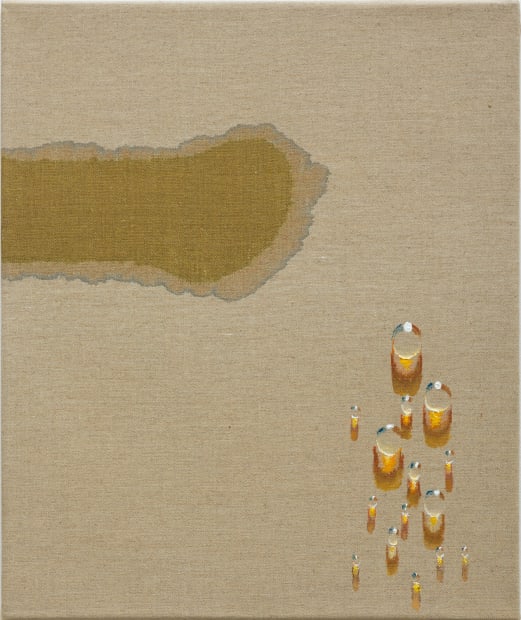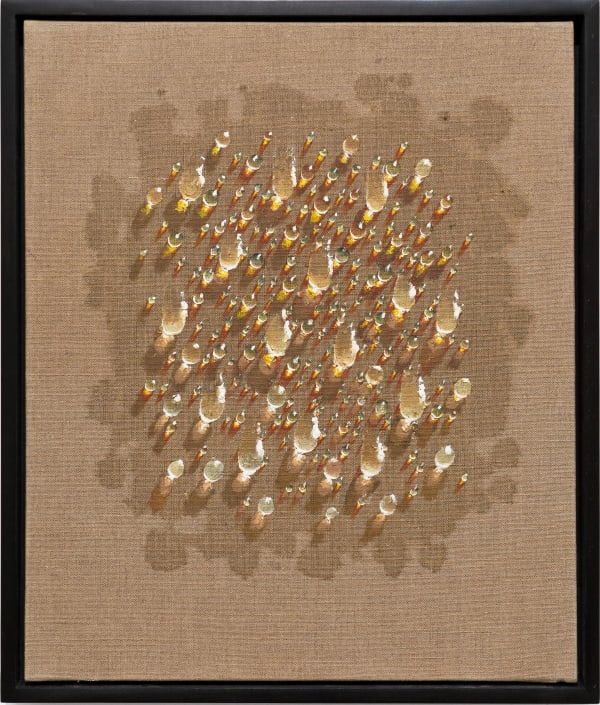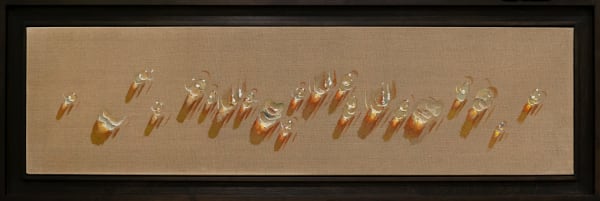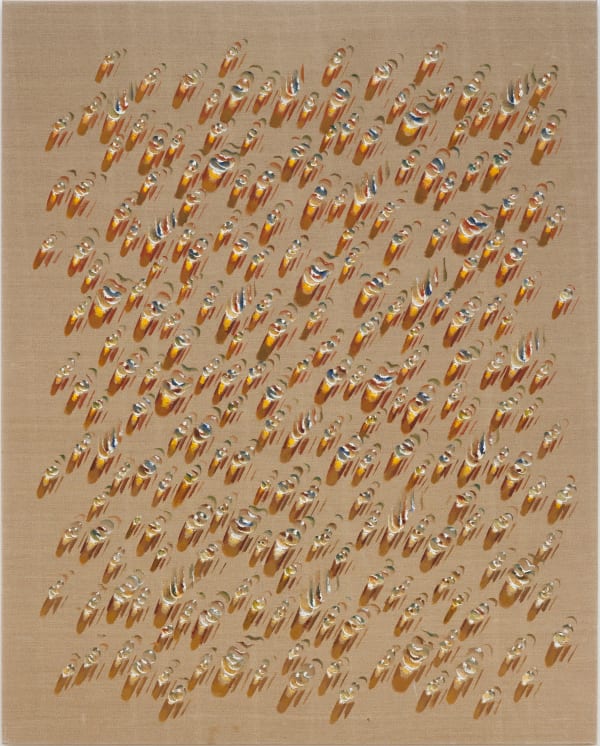-

-
Kim Tschang-Yeul: The Stillness of Water
Exhibition Walkthrough VideoVideo by Hyunjung Rhee
Text by John Yau | Edited by SoYoung Kim
Narrated by Michael McGuire
-
Kim Tschang-Yeul is one of the first generation of modern artists, who underwent the turmoil of postcolonial liberation and the Korean War. Born in Maengsan in North Korea, Kim spent his youth learning calligraphy from his grandfather and studying a series of world art collections that his uncle sent him from Japan. After studying painting at the Seoul National University, Kim became a leading member of the Korean avant-garde and co-founded the Modern Artists’ Association (later renamed Actuel in 1962) in 1958. During this time, Kim encountered Western art movements, such as the European Art Informel, through the limited information about art coming from Japan. Reinterpreting such trends, Kim and his counterparts took on radical practices and adopted the Korean Informel movement. As an avid reader, Kim was also deeply interested in literature and philosophy, in which he embraced the ideas of Taoism and Zen Buddhism. From 1965 to 1969, Kim studied in New York where Pop Art and Abstract Expressionism prevailed and began his earliest experimentation with globular abstract forms. Ultimately settling in Paris in 1969, Kim created a cultural bridge between the Korean and European art world, often hosting his native counterparts including the Dansaekhwa masters, Park Seo-Bo, Lee Ufan, and Chung Sang-Hwa.
-
“Paris is different from New York […] Here various trends coexist. The ambiance in Paris gave me the strength to show my work.”
-
With his sensibility of East Asian roots and exposure to influences of the French Informel, Pop Art and Abstract Expressionism from New York, and Surrealism and Dadaism from Paris, Kim began producing opaque, phlegmatic forms that appear to ooze out through the canvas plane in 1971. Navigating between different modes of transcontinental art movements that he gleaned from home and abroad, Kim unveiled his first waterdrop work, Événement de la nuit (1972), the following year, at Salon de Mai in Paris, France.
Since then, Kim has devoted his life-long career to depicting the drop of water, allowing him to confront and absolve his ego. Such an idea of removing his ego is very close to Taoism and Zen Buddhism, for Kim has often credited the discovery of the water drop partly to those influences. Lifelike yet mystical, each motif embodies an abdication of the self. It also mirrors the artist’s memories of war and acts of meditation.
-
“To paint water drops is to erase all memories, all evils, and the anguish [to be] destroyed with water.”
-
Although Kim’s oeuvre may be defined by the water drop, the iconic imagery is not a singular aesthetic decision, but a continuous paradigm leveraged over time in a plethora of outcomes. Kim mastered airbrush techniques to achieve a level of control he needed in visualizing the motif on raw canvas. In consequence, the trompe l’oeil fixes the aqueous orbs through his manipulation of light and surface. Still, Kim purposely avoided depicting his drops as hyper-realistic, which naturally led him to find new canvas supports such as jute, sand, wood, and newspaper. Thus new dialogues between the drops of water, backgrounds, and materiality fortified different experimental approaches for the artist.
-

Kim Tschang-Yeul
Waterdrops, 1983Oil, india ink and acrylic on canvas
75.98 x 114.57 inches
193 x 291 cm -
1979 can be considered a turning point for Kim Tschang-Yeul, as he began transitioning away from utilizing strictly airbrush techniques. For Kim, the initial purpose of using the airbrush was twofold: to remove himself from the canvas while obtaining mechanistic water drops. Yet he felt the urge to achieve a stronger adherence between his iconic motif and the screen. As if to decisively integrate his presence on the canvas surface, he began incorporating paintbrush work to engender the pictorial formativeness of the motif itself. Beginning in the 1980s and onward, the water drops became fuller and more diverse in their forms, scales, projections, and compositions, with blots appearing more abundantly. In the work Waterdrops (1983), the duplicated droplets, which are depicted in a demarcated background, protrude out of each section with their translucency rendered in a vivid contrast of light and shadow. The images of stains gently denote the artist’s intensified touch and calligraphic strokes; each element in the work demonstrates notions beyond simple representations of water drops.
-
-
Kim Tschang-Yeul further incorporates new elements traditionally unseen in his practice as evident in Waterdrops (1995), in which a flat patch of black paint disrupts the trompe l’oeil. He would also introduce a thick cloud of colorful pigments in the work Waterdrops (1996), their impasto weighing heavily on the upper left corner of the canvas. In a diagonal yet balanced composition, glistening water droplets are sitting at the other pole of the surface. Often incorporating his repeated motif of the Thousand Character Classic that profoundly resonates both his childhood memories and his Taoist philosophy, Kim persisted in greater variety in relation to his signature motif, while still acknowledging insurmountable barriers of a two-dimensional painting. Yet such experimentations delineate a complex confluence of his worldly enlightenment and physicality, which are crystallized into drops of water in perpetual stillness. In Kim’s words, “Painting for me, is to show something different, something that is made by hand, and manages to move people. But it is also intellectual play and an act of meditation and prayer.”
-
It is an honor and a privilege to exhibit the work of Kim Tschang-Yeul, and Tina Kim Gallery would like to commemorate his legacy by presenting a holistic vision of Kim’s discipline. His water drops, the depths and waves of his practice and career, define the highest qualities one can achieve through artistry.
Following this exhibition, a monograph on Kim Tschang-Yeul will be designed by Cecil studio and published by Gregory R Miller & Co., which will feature texts by art critic John Yau and Yeon Shim Chung, Professor of Art History at Hongik University in Korea.
-
Featured Works
-
Kim Tschang-Yeul's Drawing Book
Flipping through the pages of Kim Tschang-Yeul's sketchbook of water drop studies reveals the artist's careful consideration of his central motif and exposes unseen aspects of his process. Leaves hold austere compositions of photorealistic drops and unconfined gestures only suggestive of the principle of Kim's oeuvre; some approach finished works, while others represent Kim Tschang Yeul's dissection of the water drop into sheer form.
![]() 525 West 21st Street, New York, NY 10011 T 1‑212‑716‑1100 info@tinakimgallery.com
525 West 21st Street, New York, NY 10011 T 1‑212‑716‑1100 info@tinakimgallery.com
Facebook, opens in a new tab.
Instagram, opens in a new tab.
Youtube, opens in a new tab.
Artsy, opens in a new tab.
Ocula, opens in a new tab.
Copyright © 2025 Tina Kim Gallery
This website uses cookies
This site uses cookies to help make it more useful to you. Please contact us to find out more about our Cookie Policy.
뉴스레터 구독
* denotes required fields
We will process the personal data you have supplied in accordance with our privacy policy (available on request). You can unsubscribe or change your preferences at any time by clicking the link in our emails.





















